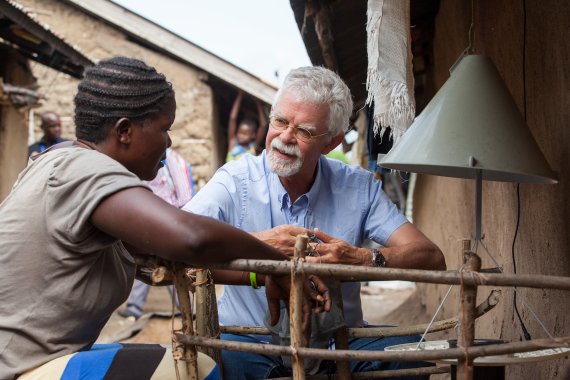In the summer of 2016, WUR presented the results of a successful malaria project on Rusinga island. The 4300 homes on the Kenyan island had each been given an odour trap to catch the malaria mosquitoes in the house and a solar panel to provide the trap with electricity. As a result, the malaria mosquito population fell by 70 per cent between 2012 and 2015, and the number of new malaria cases dropped by 30 per cent. The conclusion: odour traps are a very effective instrument for combating malaria in Africa.
The successful practical experiment was set up by Willem Takken, professor holding a personal chair in Medical Entomology. He has spent his entire scientific career fighting malaria with biological tools. This time, he was successful because a carefully chosen mix of odours that was developed in Wageningen lured the malaria mosquitoes into the trap in large numbers. The experiment made headlines around the world. Apparently, financers were queuing up to fund follow-up studies by Takken on Rusinga and in other parts of Africa.
We believe in this approach and will continue to submit project proposals
Rejected proposal
But three years on, there is no sign of a follow-up project. ‘It is not that easy,’ says Takken’s colleague Sander Koenraadt, ‘because you need a large amount of cash.’ Koenraadt wrote a proposal for practical tests in Kenya and Malawi in which odour traps around the home would be combined with impregnated cotton in the home to ward off the mosquitoes. The cost: 32 million euros. His proposal was rejected last year by Unitaid, a large international NGO that aims to improve public health around the world.
Koenraadt thinks he knows why. ‘The substance used to impregnate the cotton still needs to be registered, and additional toxicological tests are required. Unitaid doesn’t want to pay for those tests and this approach won’t be recommended by the World Health Organization until that happens.’
The odour trap has also yet to get a positive assessment from the WHO. ‘The WHO wants us to demonstrate the impact of the trap in reducing malaria in two independent studies. We have done the first study and now we are looking for funding for the second practical test; the WHO itself doesn’t have money for that.’ All in all, the Wageningen approach for tackling malaria is getting stuck in the validation phase. But Koenraadt is not giving up. ‘We believe in our approach and will continue to submit project proposals.’
Lethal disease
Willem Takken is confident there will eventually be a follow-up study. ‘Everyone agrees that we need a third method alongside mosquito nets and drugs if we are to defeat malaria. That means we need to reduce the mosquito population outside the home. The options then are odour traps and biological pest control targeting the mosquitoes and mosquito larvae.’ The need for this is as great as ever, says Takken. ‘There are still an estimated 200 million people around the world with malaria. Every year, several hundred thousand people die of the disease.’
Takken is trying to persuade the Global Fund to Fight AIDS, Tuberculosis and Malaria to fund the odour trap study. This international fund, with money from a group of rich countries, is investing in mosquito nets and drugs but is not yet funding methods for dealing a blow to the malaria mosquitoes. Takken is also looking into whether the Bill and Melinda Gates Foundation is willing to support the research again. ‘We received money from the Gates Foundation back in 2005 for large-scale tests of our odour mixes. That led to the breakthrough that made the practical test on Rusinga possible.’

Meanwhile in Kenya
How are things going now on the malaria island in Kenya? Koenraadt and Takken have not been back in recent years. Takken: ‘The last I heard was that all the solar panels are still working but about half the odour traps have stopped functioning. There could be all kind of reasons for that. Can people still get hold of the bait mixtures, which need to be refreshed every three months? Or have people stopped maintaining the odour traps because the malaria has been curbed to such an extent? We don’t know because we haven’t been able to get funding for a follow-up in the area.’
Willem Takken’s achievements

Willem Takken, professor holding a personal chair in Medical Entomology and the man behind the malaria island project, retired on 13 June. He sees the practical test in Kenya as his ‘finest hour’. ‘I remember I was surprised that the research proposal made it. Then the results were positive and the project became world news.’
But Takken can look back on other achievements too. He became the founding father 15 years ago of tick research in the Netherlands. ‘No one was researching ticks back then even though there were more and more patients with Lyme disease. I started studying where the ticks were, how many there were and what the infection rate was per area. Then I set up the tick radar with Arnold van Vliet, then the public health institute RIVM got involved, and now we have a solid group of tick researchers.’
Takken was also a key adviser to the ministry of Agriculture when there was an outbreak of bluetongue among sheep in Limburg in 2006. ‘On the first day of my holiday, I got a phone call asking me to come at once, because sheep were dying. No one had expected this disease in the Netherlands so the politicians were in panic mode. We worked out within a week what kind of midges had transmitted the viral disease.’

 Photo: Melchert Meijer zu Schlochtern
Photo: Melchert Meijer zu Schlochtern